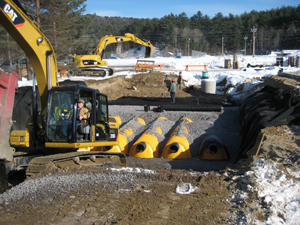Underground Storm Water Detention
Storm Water Detention

Underground Storm Water Detention
Almost all new construction today requires some type of drainage analysis of the project property. Whether the developer does the analysis of the entire project in a sub-division or whether your local government requires an analysis most regulations prevent new water runoff from leaving your property. Obviously this is a simplification of the rules but basically you’re not typically allowed to alter the property in such a way that additional water will run off the property onto abutting properties.
Traditionally storm water detention was achieved by building shallow storm water detention ponds at low points in the natural terrain. Typically these ponds only hold water after rain events and remain dry for a majority of the year. More recently Low Impact Developements (LID) have become popular which require additional on-site detention on large development projects.
Underground Storm Water Detention
Recently there has been a move to use underground basins to store storm water and eliminate storm water detention ponds. We are currently building a very large commercial building for a client and it requires a rather significant storm water detention capacity. Unfortunately, the site is very small and using a traditional pond wasn’t feasible. Therefore for this project we’re using underground storm water detention basins called StormTech Chambers. StormTech chambers are a corrogated plastic pipe that’s used to create underground basins.
The StormTech chambers are really easy to install and very cost effective. As you can see in the photo the chambers are laid out in a grid pattern and connected using pipes according to the design calculations. The chambers can even support truck traffic when installed according to the manufacturers specifications.
Underground storm water detention basins offer several benefits. First of all there’s no lost usable space on the property. Storm water detention ponds use considerable land and reduce the effective usable space on lots. Underground storm water basins also eliminate ponds that could pose a health issue due to insects and accidental drowning.
If you’re forced to create storm water detention on a project then look into using underground storm water detention basins.













Leave a comment